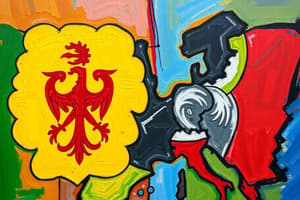Podcast
Questions and Answers
Who was the key architect behind the unification of Germany?
Who was the key architect behind the unification of Germany?
- The Prussian army generals
- Otto von Bismarck (correct)
- Kaiser Wilhelm I
- Junkers of Prussia
What major shift occurred in nationalism in Europe after 1848?
What major shift occurred in nationalism in Europe after 1848?
- It became more strongly associated with democracy and revolution.
- It was primarily driven by socialist ideologies.
- It resulted in significant territorial losses for nation-states.
- It was used by conservatives to promote state power. (correct)
What was the significance of the assembly at the Hall of Mirrors in Versailles?
What was the significance of the assembly at the Hall of Mirrors in Versailles?
- It was where the French Empire was re-established.
- It marked the beginning of the Industrial Revolution in Germany.
- It led to the disbandment of the Prussian military.
- It was the proclamation of the new German Empire. (correct)
What role did the Prussian army and bureaucracy play in German unification?
What role did the Prussian army and bureaucracy play in German unification?
What was one focus of the new German state after unification?
What was one focus of the new German state after unification?
After 1848, nationalism in Europe moved away from its association with ______ and revolution.
After 1848, nationalism in Europe moved away from its association with ______ and revolution.
Prussia took on the leadership of the movement for national ______.
Prussia took on the leadership of the movement for national ______.
The assembly at the Hall of Mirrors proclaimed the new German Empire headed by Kaiser ______ I of Prussia.
The assembly at the Hall of Mirrors proclaimed the new German Empire headed by Kaiser ______ I of Prussia.
Otto von Bismarck was the chief ______ during the unification of Germany.
Otto von Bismarck was the chief ______ during the unification of Germany.
The process of unification involved three wars over seven years, ending in Prussian ______.
The process of unification involved three wars over seven years, ending in Prussian ______.
Flashcards are hidden until you start studying
Study Notes
Nationalism and State Power in Europe
- After 1848, European nationalism shifted from revolutionary ideals to supporting state power and political dominance.
- This shift is evident in the unification of Germany and Italy, where nationalist sentiment was used by conservative powers to achieve political control.
Germany's Unification: A Prussian-Led Process
- Middle-class Germans in 1848 attempted to unify the German confederation through liberal means with an elected parliament.
- This initiative was suppressed by a combination of forces: the monarchy, the military, and the powerful Junkers (large landowners) of Prussia.
- Prussia subsequently assumed leadership of the unification movement, with Otto von Bismarck as its chief architect.
- Prussia achieved unification through a series of wars: against Denmark, Austria, and France. These wars resulted in Prussian victories.
- The process culminated in the proclamation of William I as German Emperor at Versailles in January 1871.
The Impact of Prussian Power
- The unification process in Germany highlighted the dominance of Prussian state power.
- The new German Empire emphasized modernization, introducing changes to the currency, banking, legal, and judicial systems based on Prussian models.
- Prussian practices often became a standard for the rest of Germany.
Nationalism after 1848
- Nationalism in Europe shifted away from its association with democracy and revolution.
- Conservatives began utilizing nationalistic sentiment to enhance state power and achieve political dominance.
- The unification of Germany and Italy exemplifies this shift in nationalism.
Unification of Germany
- In 1848, middle-class Germans sought to unite the German Confederation into a nation-state through an elected parliament.
- This liberal approach to nation-building was suppressed by Prussian monarchy, military, and landowners (Junkers).
- Prussia took the lead in the movement for national unification under Otto von Bismarck.
- Bismarck, aided by the Prussian Army and bureaucracy, orchestrated three wars over seven years (with Austria, Denmark, and France).
- Prussian victories in these wars led to the unification of Germany.
- In January 1871, William I, the Prussian King, was proclaimed German Emperor at Versailles.
- The unification ceremony took place in the unheated Hall of Mirrors at the Palace of Versailles.
- Representatives from German states, the army, and Prussian officials, including Bismarck, were present.
- Germany's unification highlighted the dominance of Prussian state power.
New German State
- The newly formed German state focused on modernizing currency, banking, legal, and judicial systems.
- Prussian practices and measures became models for the rest of Germany.
Studying That Suits You
Use AI to generate personalized quizzes and flashcards to suit your learning preferences.




